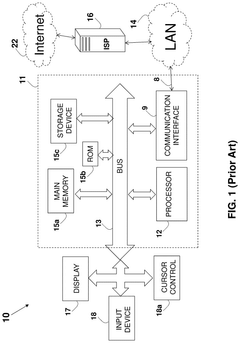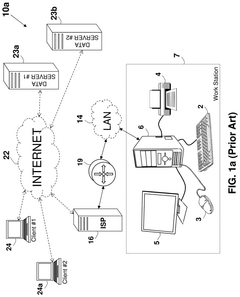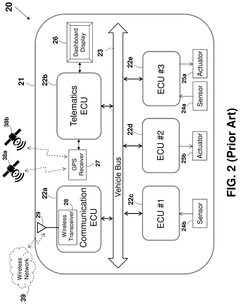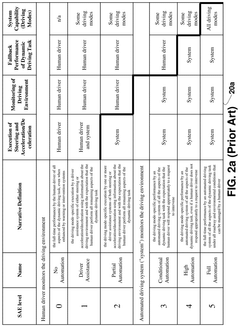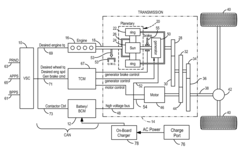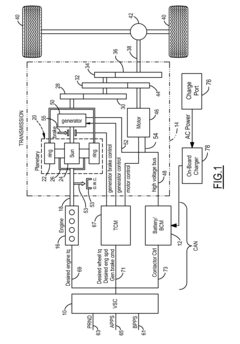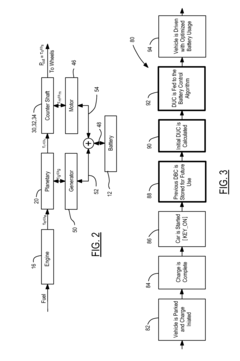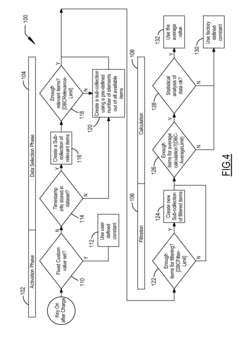PHEV's influence on urban mobility transformations
AUG 14, 20259 MIN READ
Generate Your Research Report Instantly with AI Agent
Patsnap Eureka helps you evaluate technical feasibility & market potential.
PHEV Technology Evolution
The evolution of Plug-in Hybrid Electric Vehicle (PHEV) technology has been a significant driver in the transformation of urban mobility. This technological progression can be traced through several key stages, each marked by notable advancements and innovations.
In the early 2000s, the first generation of PHEVs emerged, characterized by limited electric-only range and relatively simple hybrid systems. These vehicles primarily relied on their internal combustion engines, with electric power serving as a supplementary source. The battery technology was predominantly based on nickel-metal hydride (NiMH) chemistry, offering modest energy density and power output.
As the decade progressed, lithium-ion battery technology began to revolutionize PHEV capabilities. This shift allowed for increased energy storage capacity and improved power delivery, resulting in extended electric-only ranges and enhanced overall performance. Manufacturers started to introduce more sophisticated power management systems, optimizing the interplay between electric and combustion propulsion.
The 2010s saw a rapid acceleration in PHEV development. Advanced battery management systems and more efficient electric motors led to significant improvements in energy efficiency and electric driving range. Regenerative braking systems became more refined, capturing and storing a greater proportion of kinetic energy during deceleration. Additionally, the integration of smart charging technologies and vehicle-to-grid (V2G) capabilities began to emerge, laying the groundwork for PHEVs to play a role in grid stabilization and energy management.
In recent years, PHEV technology has focused on further extending electric range and reducing reliance on fossil fuels. Many modern PHEVs now offer electric-only ranges exceeding 50 miles, making them suitable for most daily urban commutes without engaging the combustion engine. Advancements in power electronics and thermal management have resulted in faster charging capabilities and improved overall system efficiency.
The latest generation of PHEVs incorporates artificial intelligence and machine learning algorithms to optimize power distribution and driving modes based on route information, traffic conditions, and driver behavior. These smart systems can predictively manage energy usage, further enhancing efficiency and reducing emissions in urban environments.
Looking ahead, PHEV technology is poised for continued evolution. Research is underway to develop solid-state batteries, which promise higher energy density, faster charging times, and improved safety. Integration with autonomous driving technologies and smart city infrastructure is expected to further optimize PHEV performance in urban settings, potentially revolutionizing traffic flow and energy consumption patterns.
In the early 2000s, the first generation of PHEVs emerged, characterized by limited electric-only range and relatively simple hybrid systems. These vehicles primarily relied on their internal combustion engines, with electric power serving as a supplementary source. The battery technology was predominantly based on nickel-metal hydride (NiMH) chemistry, offering modest energy density and power output.
As the decade progressed, lithium-ion battery technology began to revolutionize PHEV capabilities. This shift allowed for increased energy storage capacity and improved power delivery, resulting in extended electric-only ranges and enhanced overall performance. Manufacturers started to introduce more sophisticated power management systems, optimizing the interplay between electric and combustion propulsion.
The 2010s saw a rapid acceleration in PHEV development. Advanced battery management systems and more efficient electric motors led to significant improvements in energy efficiency and electric driving range. Regenerative braking systems became more refined, capturing and storing a greater proportion of kinetic energy during deceleration. Additionally, the integration of smart charging technologies and vehicle-to-grid (V2G) capabilities began to emerge, laying the groundwork for PHEVs to play a role in grid stabilization and energy management.
In recent years, PHEV technology has focused on further extending electric range and reducing reliance on fossil fuels. Many modern PHEVs now offer electric-only ranges exceeding 50 miles, making them suitable for most daily urban commutes without engaging the combustion engine. Advancements in power electronics and thermal management have resulted in faster charging capabilities and improved overall system efficiency.
The latest generation of PHEVs incorporates artificial intelligence and machine learning algorithms to optimize power distribution and driving modes based on route information, traffic conditions, and driver behavior. These smart systems can predictively manage energy usage, further enhancing efficiency and reducing emissions in urban environments.
Looking ahead, PHEV technology is poised for continued evolution. Research is underway to develop solid-state batteries, which promise higher energy density, faster charging times, and improved safety. Integration with autonomous driving technologies and smart city infrastructure is expected to further optimize PHEV performance in urban settings, potentially revolutionizing traffic flow and energy consumption patterns.
Urban Mobility Market Analysis
The urban mobility market is undergoing significant transformations, driven by technological advancements, changing consumer preferences, and environmental concerns. Plug-in Hybrid Electric Vehicles (PHEVs) have emerged as a key player in this evolving landscape, offering a bridge between conventional internal combustion engines and fully electric vehicles. The market for urban mobility solutions has seen substantial growth in recent years, with a particular focus on sustainable and efficient transportation options.
PHEVs have gained traction in urban environments due to their ability to operate on both electric power and conventional fuel, providing flexibility for city dwellers. This dual-mode capability addresses range anxiety concerns while still offering the benefits of electric propulsion for short urban trips. As a result, the adoption of PHEVs in urban areas has been steadily increasing, contributing to the overall growth of the electrified vehicle market.
The urban mobility market analysis reveals a shift in consumer behavior towards more environmentally friendly transportation options. PHEVs align well with this trend, offering reduced emissions and improved fuel efficiency compared to traditional vehicles. This has led to increased demand for PHEVs in urban centers, where air quality concerns and stringent emissions regulations are driving factors.
Market data indicates that the global PHEV market has been experiencing robust growth, with urban areas contributing significantly to this expansion. The integration of PHEVs into urban mobility ecosystems has also spurred the development of supporting infrastructure, such as charging stations and smart grid technologies. This symbiotic relationship between PHEVs and urban infrastructure has created new business opportunities and market segments within the broader urban mobility landscape.
The influence of PHEVs on urban mobility transformations extends beyond personal transportation. Fleet operators, including taxi services and car-sharing platforms, have begun incorporating PHEVs into their offerings, recognizing the benefits of lower operating costs and improved environmental performance. This trend has further accelerated the adoption of PHEVs in urban settings and has contributed to the diversification of mobility options available to city residents.
As urban populations continue to grow and cities face increasing pressure to reduce carbon emissions, the role of PHEVs in shaping urban mobility is expected to become more pronounced. The market analysis suggests that PHEVs will play a crucial role in the transition towards fully electric urban transportation systems, serving as an important stepping stone in the evolution of urban mobility.
PHEVs have gained traction in urban environments due to their ability to operate on both electric power and conventional fuel, providing flexibility for city dwellers. This dual-mode capability addresses range anxiety concerns while still offering the benefits of electric propulsion for short urban trips. As a result, the adoption of PHEVs in urban areas has been steadily increasing, contributing to the overall growth of the electrified vehicle market.
The urban mobility market analysis reveals a shift in consumer behavior towards more environmentally friendly transportation options. PHEVs align well with this trend, offering reduced emissions and improved fuel efficiency compared to traditional vehicles. This has led to increased demand for PHEVs in urban centers, where air quality concerns and stringent emissions regulations are driving factors.
Market data indicates that the global PHEV market has been experiencing robust growth, with urban areas contributing significantly to this expansion. The integration of PHEVs into urban mobility ecosystems has also spurred the development of supporting infrastructure, such as charging stations and smart grid technologies. This symbiotic relationship between PHEVs and urban infrastructure has created new business opportunities and market segments within the broader urban mobility landscape.
The influence of PHEVs on urban mobility transformations extends beyond personal transportation. Fleet operators, including taxi services and car-sharing platforms, have begun incorporating PHEVs into their offerings, recognizing the benefits of lower operating costs and improved environmental performance. This trend has further accelerated the adoption of PHEVs in urban settings and has contributed to the diversification of mobility options available to city residents.
As urban populations continue to grow and cities face increasing pressure to reduce carbon emissions, the role of PHEVs in shaping urban mobility is expected to become more pronounced. The market analysis suggests that PHEVs will play a crucial role in the transition towards fully electric urban transportation systems, serving as an important stepping stone in the evolution of urban mobility.
PHEV Integration Challenges
The integration of Plug-in Hybrid Electric Vehicles (PHEVs) into urban mobility systems presents several significant challenges. One of the primary obstacles is the development of adequate charging infrastructure. Cities must strategically plan and implement a network of charging stations to support the growing number of PHEVs. This requires substantial investment in both public and private charging facilities, as well as coordination between city planners, utility companies, and property owners.
Another challenge lies in the management of electricity grid capacity and demand. As PHEVs become more prevalent, the increased electricity consumption for charging could strain existing power grids, particularly during peak hours. Smart grid technologies and load balancing systems need to be implemented to ensure grid stability and prevent localized power outages.
The integration of PHEVs also raises concerns about battery technology and its limitations. Current battery capacities may not be sufficient for longer trips, potentially leading to range anxiety among users. This challenge necessitates ongoing research and development in battery technology to improve energy density, charging speeds, and overall performance.
Furthermore, the adoption of PHEVs requires changes in consumer behavior and perceptions. Many urban residents may be hesitant to switch to PHEVs due to concerns about initial costs, charging convenience, and vehicle performance. Overcoming these psychological barriers through education, incentives, and improved user experiences is crucial for widespread PHEV integration.
Urban planning and traffic management systems must also adapt to accommodate PHEVs. This includes redesigning parking spaces to include charging facilities, updating traffic flow models to account for PHEV driving patterns, and potentially implementing new traffic management strategies that prioritize or incentivize PHEV usage in certain areas.
The environmental impact of PHEVs in urban settings is another challenge that needs careful consideration. While PHEVs can reduce local emissions, the overall environmental benefit depends on the source of electricity used for charging. Cities must work towards cleaner energy sources to maximize the environmental advantages of PHEV adoption.
Lastly, the integration of PHEVs into urban mobility systems requires significant policy and regulatory changes. This includes developing new standards for charging infrastructure, updating building codes to accommodate charging stations, and creating incentives or regulations to encourage PHEV adoption. Balancing these policies with other urban priorities and ensuring equitable access to PHEV technology across different socioeconomic groups presents an ongoing challenge for city administrators and policymakers.
Another challenge lies in the management of electricity grid capacity and demand. As PHEVs become more prevalent, the increased electricity consumption for charging could strain existing power grids, particularly during peak hours. Smart grid technologies and load balancing systems need to be implemented to ensure grid stability and prevent localized power outages.
The integration of PHEVs also raises concerns about battery technology and its limitations. Current battery capacities may not be sufficient for longer trips, potentially leading to range anxiety among users. This challenge necessitates ongoing research and development in battery technology to improve energy density, charging speeds, and overall performance.
Furthermore, the adoption of PHEVs requires changes in consumer behavior and perceptions. Many urban residents may be hesitant to switch to PHEVs due to concerns about initial costs, charging convenience, and vehicle performance. Overcoming these psychological barriers through education, incentives, and improved user experiences is crucial for widespread PHEV integration.
Urban planning and traffic management systems must also adapt to accommodate PHEVs. This includes redesigning parking spaces to include charging facilities, updating traffic flow models to account for PHEV driving patterns, and potentially implementing new traffic management strategies that prioritize or incentivize PHEV usage in certain areas.
The environmental impact of PHEVs in urban settings is another challenge that needs careful consideration. While PHEVs can reduce local emissions, the overall environmental benefit depends on the source of electricity used for charging. Cities must work towards cleaner energy sources to maximize the environmental advantages of PHEV adoption.
Lastly, the integration of PHEVs into urban mobility systems requires significant policy and regulatory changes. This includes developing new standards for charging infrastructure, updating building codes to accommodate charging stations, and creating incentives or regulations to encourage PHEV adoption. Balancing these policies with other urban priorities and ensuring equitable access to PHEV technology across different socioeconomic groups presents an ongoing challenge for city administrators and policymakers.
Current PHEV Solutions
01 Charging systems for PHEVs
Plug-in Hybrid Electric Vehicles (PHEVs) require efficient charging systems to optimize their performance. These systems may include advanced charging stations, smart grid integration, and wireless charging technologies. Innovations in this area focus on improving charging speed, convenience, and compatibility with various power sources.- Charging systems for PHEVs: Advanced charging systems are developed for PHEVs to improve efficiency and convenience. These systems may include wireless charging capabilities, fast-charging technologies, and smart grid integration for optimal energy management. Such innovations aim to reduce charging times, increase charging accessibility, and enhance overall user experience.
- Powertrain optimization in PHEVs: PHEV powertrains are optimized to balance performance, efficiency, and emissions. This involves advanced control strategies for switching between electric and combustion modes, regenerative braking systems, and intelligent power distribution. These improvements aim to maximize electric range, reduce fuel consumption, and minimize environmental impact.
- Battery management and thermal control: Effective battery management and thermal control systems are crucial for PHEV performance and longevity. These systems monitor and regulate battery temperature, state of charge, and overall health. Advanced cooling and heating mechanisms are implemented to maintain optimal battery conditions across various operating environments.
- Vehicle-to-grid (V2G) integration: PHEVs are being developed with V2G capabilities, allowing them to interact with the power grid. This technology enables PHEVs to serve as mobile energy storage units, potentially supplying power back to the grid during peak demand periods. V2G integration can contribute to grid stability and provide additional value to PHEV owners.
- Lightweight materials and aerodynamic design: PHEVs incorporate lightweight materials and aerodynamic designs to improve overall efficiency. Advanced composites, high-strength alloys, and innovative manufacturing techniques are used to reduce vehicle weight. Aerodynamic enhancements, such as active grille shutters and underbody panels, help minimize drag and increase electric range.
02 Energy management and powertrain control
PHEVs utilize sophisticated energy management systems to balance the use of electric and combustion power sources. These systems optimize fuel efficiency, reduce emissions, and enhance overall vehicle performance. Advanced control algorithms and predictive technologies are employed to manage power distribution between the electric motor and internal combustion engine.Expand Specific Solutions03 Battery technology and range extension
Improving battery technology is crucial for extending the electric range of PHEVs. This includes developing high-capacity batteries, enhancing battery management systems, and implementing regenerative braking technologies. Innovations in this area aim to increase energy density, reduce charging times, and prolong battery life.Expand Specific Solutions04 Hybrid powertrain configurations
Various hybrid powertrain configurations are being developed for PHEVs to optimize performance and efficiency. These may include series, parallel, or series-parallel hybrid systems. Innovations focus on integrating electric motors, internal combustion engines, and transmission systems to achieve the best balance of power, efficiency, and drivability.Expand Specific Solutions05 Vehicle-to-grid (V2G) integration
PHEVs are being designed with vehicle-to-grid (V2G) capabilities, allowing them to interact with the power grid. This technology enables PHEVs to not only draw power from the grid but also feed excess energy back, potentially stabilizing the grid and providing additional value to vehicle owners. V2G integration involves advanced communication systems and smart charging infrastructure.Expand Specific Solutions
Key PHEV Manufacturers
The PHEV market is in a growth phase, with increasing adoption driven by environmental concerns and government incentives. The global PHEV market size is projected to expand significantly in the coming years, reflecting the growing demand for more sustainable urban mobility solutions. Technologically, PHEVs are relatively mature, with major automakers like Ford, Jaguar Land Rover, and BMW offering advanced models. However, there's ongoing innovation in battery technology and powertrain efficiency, with companies like LG Energy Solution and BorgWarner leading developments. The competitive landscape is diverse, including traditional automakers and new entrants, all vying to improve range, performance, and charging infrastructure to accelerate urban mobility transformation.
Ford Motor Co.
Technical Solution: Ford's PHEV strategy focuses on developing advanced powertrains that combine electric and combustion engines. Their latest PHEV models, such as the Ford Escape PHEV, offer an all-electric range of up to 37 miles and a total range of over 500 miles[1]. Ford is also investing in smart charging technologies and vehicle-to-grid (V2G) capabilities to enhance urban grid stability. The company is collaborating with cities to implement PHEV-friendly infrastructure, including dedicated charging lanes and smart parking solutions[2]. Ford's PHEVs utilize a power-split architecture that allows for seamless transition between electric and hybrid modes, optimizing efficiency in urban environments[3].
Strengths: Extensive experience in hybrid technology, strong brand recognition, and established urban mobility partnerships. Weaknesses: Relatively limited all-electric range compared to some competitors, and potential challenges in battery supply chain.
Dongfeng Motor Group Co., Ltd.
Technical Solution: Dongfeng's PHEV strategy for urban mobility transformation focuses on developing affordable and efficient models tailored for the Chinese market, which is crucial for global urban mobility trends. Their PHEV models, such as the Dongfeng Fengshen A9, utilize a parallel hybrid system that offers improved fuel efficiency in urban driving conditions[7]. Dongfeng is investing in localized battery production and charging infrastructure to reduce costs and improve accessibility. The company is also collaborating with urban planners to integrate PHEVs into smart city initiatives, including dedicated low-emission zones and intelligent traffic management systems[8]. Dongfeng's PHEVs incorporate advanced connectivity features that allow for real-time optimization of energy use based on urban traffic patterns and air quality data.
Strengths: Strong presence in the world's largest auto market, government support for new energy vehicles, and cost-effective manufacturing. Weaknesses: Limited global brand recognition and potential challenges in meeting international emissions standards.
PHEV Technological Innovations
Method and Apparatus for Planning an Electric Car Trip
PatentPendingUS20240361137A1
Innovation
- A system that integrates environmental, car, and driver factors into navigation route planning using a computer system connected to the internet, utilizing sensors and data analytics to optimize routes based on real-time data.
Adaptive Initial Estimation and Dynamic Determination and Update of Distance Until Charge of a Plug-In Hybrid Electric Vehicle
PatentActiveUS20110184600A1
Innovation
- A method and system that dynamically control battery usage based on the estimated or user-provided 'distance until charge' (DUC) value, utilizing historical data and real-time information from navigation systems to optimize battery depletion and charging strategies.
Environmental Impact Assessment
The environmental impact of Plug-in Hybrid Electric Vehicles (PHEVs) on urban mobility transformations is multifaceted and significant. These vehicles, which combine conventional internal combustion engines with electric propulsion systems, offer a transitional solution between traditional vehicles and fully electric ones, potentially mitigating some of the environmental concerns associated with urban transportation.
One of the primary environmental benefits of PHEVs is their potential to reduce greenhouse gas emissions. When operating in electric mode, PHEVs produce zero tailpipe emissions, contributing to improved air quality in urban areas. This is particularly crucial in densely populated cities where air pollution from vehicle emissions is a major health concern. Studies have shown that widespread adoption of PHEVs could lead to a substantial reduction in urban carbon dioxide emissions, depending on the electricity generation mix of the region.
However, the environmental impact of PHEVs is not uniformly positive. The production of batteries for these vehicles involves energy-intensive processes and the extraction of rare earth metals, which can have negative environmental consequences. The disposal and recycling of these batteries at the end of their lifecycle also present environmental challenges that need to be addressed.
The influence of PHEVs on urban mobility patterns can lead to indirect environmental effects. For instance, the increased range and flexibility offered by PHEVs might encourage more frequent or longer trips, potentially offsetting some of the environmental gains. Conversely, the ability to charge PHEVs at home or work could reduce the need for dedicated refueling infrastructure, potentially freeing up urban space for other uses such as green areas or pedestrian zones.
The environmental impact of PHEVs is also closely tied to the source of electricity used for charging. In regions where electricity is primarily generated from renewable sources, the environmental benefits of PHEVs are more pronounced. However, in areas heavily reliant on fossil fuels for electricity generation, the overall environmental advantage of PHEVs may be less significant.
As cities transition towards more sustainable transportation systems, PHEVs can play a role in reducing noise pollution. The electric mode of these vehicles operates much more quietly than traditional internal combustion engines, contributing to a reduction in urban noise levels, particularly during low-speed city driving.
In conclusion, while PHEVs offer potential environmental benefits in urban mobility transformations, their impact is complex and dependent on various factors. A comprehensive assessment must consider not only direct emissions but also lifecycle impacts, energy sources, and changes in mobility patterns to fully understand the environmental implications of PHEV adoption in urban settings.
One of the primary environmental benefits of PHEVs is their potential to reduce greenhouse gas emissions. When operating in electric mode, PHEVs produce zero tailpipe emissions, contributing to improved air quality in urban areas. This is particularly crucial in densely populated cities where air pollution from vehicle emissions is a major health concern. Studies have shown that widespread adoption of PHEVs could lead to a substantial reduction in urban carbon dioxide emissions, depending on the electricity generation mix of the region.
However, the environmental impact of PHEVs is not uniformly positive. The production of batteries for these vehicles involves energy-intensive processes and the extraction of rare earth metals, which can have negative environmental consequences. The disposal and recycling of these batteries at the end of their lifecycle also present environmental challenges that need to be addressed.
The influence of PHEVs on urban mobility patterns can lead to indirect environmental effects. For instance, the increased range and flexibility offered by PHEVs might encourage more frequent or longer trips, potentially offsetting some of the environmental gains. Conversely, the ability to charge PHEVs at home or work could reduce the need for dedicated refueling infrastructure, potentially freeing up urban space for other uses such as green areas or pedestrian zones.
The environmental impact of PHEVs is also closely tied to the source of electricity used for charging. In regions where electricity is primarily generated from renewable sources, the environmental benefits of PHEVs are more pronounced. However, in areas heavily reliant on fossil fuels for electricity generation, the overall environmental advantage of PHEVs may be less significant.
As cities transition towards more sustainable transportation systems, PHEVs can play a role in reducing noise pollution. The electric mode of these vehicles operates much more quietly than traditional internal combustion engines, contributing to a reduction in urban noise levels, particularly during low-speed city driving.
In conclusion, while PHEVs offer potential environmental benefits in urban mobility transformations, their impact is complex and dependent on various factors. A comprehensive assessment must consider not only direct emissions but also lifecycle impacts, energy sources, and changes in mobility patterns to fully understand the environmental implications of PHEV adoption in urban settings.
Infrastructure Requirements
The integration of Plug-in Hybrid Electric Vehicles (PHEVs) into urban mobility systems necessitates significant infrastructure adaptations. A key requirement is the development of an extensive charging network to support the growing fleet of PHEVs. This network should include a mix of slow-charging stations for overnight charging at residences and workplaces, as well as fast-charging stations strategically located throughout urban areas for quick top-ups during the day.
Urban planners and policymakers must consider the spatial distribution of charging infrastructure to ensure equitable access across different neighborhoods. This may involve retrofitting existing parking structures with charging capabilities and incorporating charging stations into new urban development projects. The power grid infrastructure will also require upgrades to handle the increased electricity demand from PHEVs, particularly during peak charging times.
Smart grid technologies play a crucial role in managing the load on the electrical system. These technologies enable dynamic pricing and load balancing, incentivizing PHEV owners to charge during off-peak hours. Additionally, vehicle-to-grid (V2G) systems could allow PHEVs to serve as distributed energy storage units, potentially contributing to grid stability during high demand periods.
Traffic management systems need to be updated to accommodate the unique characteristics of PHEVs. This includes the integration of real-time information on charging station availability into navigation systems and traffic flow optimization algorithms that consider the range limitations and charging needs of PHEVs.
Public transportation infrastructure should also be adapted to incorporate PHEVs. This may involve electrifying bus fleets with plug-in hybrid technology and establishing charging depots at bus terminals. Intermodal transportation hubs could be equipped with charging facilities to encourage the use of PHEVs in combination with public transit for longer journeys.
The transition to PHEV-friendly infrastructure requires significant investment in both physical assets and digital systems. Funding mechanisms, such as public-private partnerships or green bonds, may be necessary to finance these infrastructure improvements. Moreover, standardization of charging protocols and payment systems across different regions is essential to ensure seamless mobility for PHEV users.
As urban areas evolve to accommodate PHEVs, it is crucial to consider the long-term sustainability and scalability of the infrastructure. This includes planning for the eventual transition to fully electric vehicles and ensuring that PHEV infrastructure can be easily upgraded or repurposed as technology advances.
Urban planners and policymakers must consider the spatial distribution of charging infrastructure to ensure equitable access across different neighborhoods. This may involve retrofitting existing parking structures with charging capabilities and incorporating charging stations into new urban development projects. The power grid infrastructure will also require upgrades to handle the increased electricity demand from PHEVs, particularly during peak charging times.
Smart grid technologies play a crucial role in managing the load on the electrical system. These technologies enable dynamic pricing and load balancing, incentivizing PHEV owners to charge during off-peak hours. Additionally, vehicle-to-grid (V2G) systems could allow PHEVs to serve as distributed energy storage units, potentially contributing to grid stability during high demand periods.
Traffic management systems need to be updated to accommodate the unique characteristics of PHEVs. This includes the integration of real-time information on charging station availability into navigation systems and traffic flow optimization algorithms that consider the range limitations and charging needs of PHEVs.
Public transportation infrastructure should also be adapted to incorporate PHEVs. This may involve electrifying bus fleets with plug-in hybrid technology and establishing charging depots at bus terminals. Intermodal transportation hubs could be equipped with charging facilities to encourage the use of PHEVs in combination with public transit for longer journeys.
The transition to PHEV-friendly infrastructure requires significant investment in both physical assets and digital systems. Funding mechanisms, such as public-private partnerships or green bonds, may be necessary to finance these infrastructure improvements. Moreover, standardization of charging protocols and payment systems across different regions is essential to ensure seamless mobility for PHEV users.
As urban areas evolve to accommodate PHEVs, it is crucial to consider the long-term sustainability and scalability of the infrastructure. This includes planning for the eventual transition to fully electric vehicles and ensuring that PHEV infrastructure can be easily upgraded or repurposed as technology advances.
Unlock deeper insights with Patsnap Eureka Quick Research — get a full tech report to explore trends and direct your research. Try now!
Generate Your Research Report Instantly with AI Agent
Supercharge your innovation with Patsnap Eureka AI Agent Platform!
